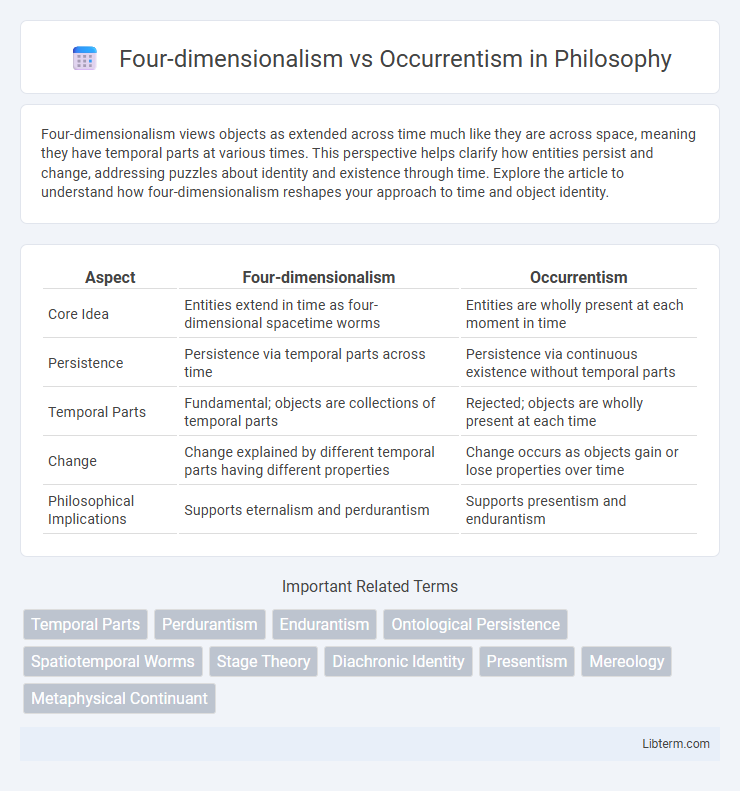Four-dimensionalism views objects as extended across time much like they are across space, meaning they have temporal parts at various times. This perspective helps clarify how entities persist and change, addressing puzzles about identity and existence through time. Explore the article to understand how four-dimensionalism reshapes your approach to time and object identity.
Table of Comparison
| Aspect | Four-dimensionalism | Occurrentism |
|---|---|---|
| Core Idea | Entities extend in time as four-dimensional spacetime worms | Entities are wholly present at each moment in time |
| Persistence | Persistence via temporal parts across time | Persistence via continuous existence without temporal parts |
| Temporal Parts | Fundamental; objects are collections of temporal parts | Rejected; objects are wholly present at each time |
| Change | Change explained by different temporal parts having different properties | Change occurs as objects gain or lose properties over time |
| Philosophical Implications | Supports eternalism and perdurantism | Supports presentism and endurantism |
Introduction to Four-dimensionalism and Occurrentism
Four-dimensionalism posits that objects extend through time as well as space, treating temporal parts as integral components of an object's existence, thereby framing persistence as a series of time-slices. Occurrentism, in contrast, maintains that only present temporal parts exist, emphasizing objects as wholly present at each moment without temporal extension. This distinction underpins debates in metaphysics regarding identity, persistence, and the nature of temporal existence.
Historical Background and Philosophical Roots
Four-dimensionalism emerged from the philosophical analysis of time and persistence, tracing its roots to the work of early 20th-century philosophers such as J.M.E. McTaggart, who discussed the nature of time's passage. Occurrentism, grounded in the substance ontology of Aristotle and further developed in analytic metaphysics, emphasizes entities as wholly present at each moment, reflecting a heritage from endurantist traditions. The divergence between these views is influenced by evolving interpretations of temporal parts theory and persistence through time debates in contemporary metaphysics.
Defining Four-dimensionalism: Core Concepts
Four-dimensionalism posits that objects extend across time as well as space, consisting of temporal parts that form their entire existence. This view contrasts with Occurrentism by emphasizing the persistence of entities through temporal segments rather than being wholly present at each moment. Core concepts include perdurance, the idea that objects are extended in four dimensions, and the ontology that treats temporal parts as fundamental components of identity.
Understanding Occurrentism: Key Principles
Occurrentism posits that objects are wholly present at any given moment, emphasizing temporal parts as distinct, non-overlapping events rather than continuous entities extended through time. This view contrasts with Four-dimensionalism, which treats objects as extended across time with temporal parts forming their identity. Key principles of Occurrentism highlight the exclusivity of present existence, rejecting the reality of past or future temporal parts to maintain a strictly presentist ontology.
Major Differences Between Four-dimensionalism and Occurrentism
Four-dimensionalism posits that objects extend through time as well as space, consisting of temporal parts that combine to form a whole, whereas Occurrentism asserts that objects are wholly present at each moment in time without temporal parts. Four-dimensionalism treats persistence as a series of temporal segments, while Occurrentism views objects as continuously occurrent entities enduring through time. This fundamental difference impacts how each theory addresses identity, change, and temporal existence in metaphysics.
Ontological Commitments of Both Theories
Four-dimensionalism posits that objects extend through time as four-dimensional entities composed of temporal parts, committing ontologically to a continuum of time-slices that constitute an object's entire existence. Occurrentism, by contrast, asserts that only present, wholly actual entities exist, rejecting temporal parts and thus committing ontologically to instantaneous, wholly present objects without temporal extension. These divergent commitments shape their respective metaphysical frameworks for persistence, with four-dimensionalism embracing perdurantism and occurrentism endorsing endurantism.
Implications for the Nature of Time and Existence
Four-dimensionalism posits that objects extend through time as temporal parts, implying that past, present, and future events are equally real and challenging the traditional notion of a flowing time. Occurrentism asserts that only present objects and events exist, emphasizing a dynamic and tensed view of time where past and future are unreal. This debate impacts metaphysical understandings of persistence, with four-dimensionalism supporting perdurantism and Occcurrentism aligning with endurantism, shaping theories about temporal ontology and existence.
Prominent Philosophers and Influential Works
Prominent philosophers advocating four-dimensionalism include David Lewis, whose work *On the Plurality of Worlds* emphasizes temporal parts and the extended existence of objects across time. In contrast, Occurrentism is championed by philosophers like Ned Markosian, who in his essay "A Defense of Presentism" critiques the four-dimensional approach and defends the view that only present objects exist occurrently. Influential works such as Theodore Sider's *Four-Dimensionalism* provide comprehensive arguments for four-dimensional ontology, while works by Dean Zimmerman challenge it by defending presentist or occurrentist perspectives.
Contemporary Debates and Critiques
Contemporary debates on four-dimensionalism and occurrentism revolve around the metaphysical interpretation of persistence through time, with critics of four-dimensionalism challenging its reliance on temporal parts and arguing that it undermines the unity of objects. Occurrentism, which denies the existence of temporal parts and maintains that objects are wholly present at each moment, faces critiques concerning its ability to account for change and temporal extension. Recent scholarly discussions emphasize the implications of these views for understanding identity, time, and change, highlighting ongoing tensions between reductive and non-reductive ontologies in metaphysics.
Conclusion: The Ongoing Relevance of the Debate
Four-dimensionalism and Occurrentism remain central in metaphysical discussions on persistence and identity over time, shaping contemporary philosophical inquiry. The debate's ongoing relevance is evident in its impact on theories of temporal parts, change, and continuity, influencing diverse areas such as ontology, philosophy of mind, and physics. Recent scholarship continues to explore their implications, demonstrating the enduring significance of these positions in understanding temporal and existential phenomena.
Four-dimensionalism Infographic

 libterm.com
libterm.com